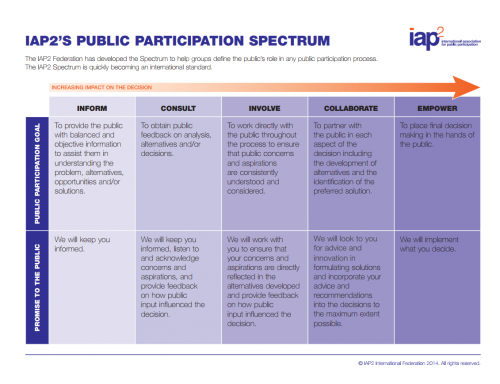Engaging the public in local government decisions: Involve
How can government better engage the public in decision-making processes?
If you’re an elected (or appointed) official, have you ever wondered if there was a better way to engage the public in local government than having them observe and maybe give public comment at an open meeting? If you’re a private citizen, have you ever wished you could be more involved in the government/decision making process? This is the fourth article in a series of Michigan State University Extension articles that examine the public’s participation in local government. The series began by discussing public comment periods at open meetings, which you can find here. Other articles introduced the International Association of Public Participation’s Public Participation Spectrum and discussed the most previous steps, Inform and Consult. Each step on the spectrum can be viewed as a commitment per level of public participation. Each level/step includes a goal for public participation, and a promise that a governmental body is making to the public regarding the level of participation that may indeed contribute to the decisions that that will be made.
This article will take a closer look at the third step on the Public Participation Spectrum: Involve.
In Involve, the goal is to work directly with the public throughout the process to ensure that public’s concerns and aspirations are consistently understood and considered. The promise is to work with the public to ensure their aspirations and concerns are directly reflected in proposed alternatives and provide feedback on how public input influenced the decision.

In Involve, the agency or department is still the ultimate decision-maker, and there is no promise of building consensus or providing the public with high-level influence over a decision, but the promise is to involve the public in forming possible solutions to a problem. This type of participation is typically appropriate when the public has some investment in an issue, but it is not expected to be highly controversial or have major implications for others.
Involving the public in a decision-making process must involve exactly that: a process. This type of participation doesn’t entail a one-time public hearing, or one event where the public can participate. In Involve, the public should be involved throughout the process.
Crucially, the public should also be involved in the design of the process. Governments seeking to improve their public engagement should be continuously seeking feedback on how the process can be improved to ensure that audiences that are traditionally not part of the process (either by choice or because efforts are not made to engage them intentionally) from participating are able to engage.
The next article in this series will look at the next level on the public participation spectrum: Collaborate.
Those in Michigan State University Extension that focus on Government and Public Policy provide various training programs, which are available to be presented in your county. Contact your local Government and Public Policy educator for more information.



 Print
Print Email
Email